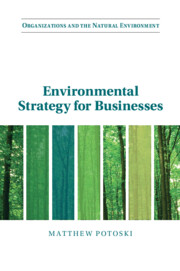Book contents
- Environmental Strategy for Businesses
- Organizations and the Natural Environment
- Environmental Strategy for Businesses
- Copyright page
- Contents
- Tables
- Preface
- 1 Introduction
- 2 Foundations and Background
- 3 Environmental Strategy Choices and Challenges
- 4 Nonmarket Strategy
- 5 Environmental Strategy and Strategic Resources
- 6 Green Products and Services
- 7 Employee Engagement
- 8 Environmental Groups
- 9 Conclusion
- References
- Index
6 - Green Products and Services
Published online by Cambridge University Press: 23 February 2023
- Environmental Strategy for Businesses
- Organizations and the Natural Environment
- Environmental Strategy for Businesses
- Copyright page
- Contents
- Tables
- Preface
- 1 Introduction
- 2 Foundations and Background
- 3 Environmental Strategy Choices and Challenges
- 4 Nonmarket Strategy
- 5 Environmental Strategy and Strategic Resources
- 6 Green Products and Services
- 7 Employee Engagement
- 8 Environmental Groups
- 9 Conclusion
- References
- Index
Summary
A green product is differentiated from similar products through an augmented sustainability feature, such as being produced with less environmental harm of having a smaller environmental impact upon disposal. The case of Stonyfield organic yogurt and the company’s founders, Samuel Kaymen and Gary Hirshberg, illustrate the challenges of selling green products. Green products need to offer co-benefits to garner consumer demands. A co-benefit is a functional, emotional, or social value that a recipient receives along with the product’s environmental benefits. Stonyfield’s organic yogurt offered consumers health and warm-glow emotional co-benefits stemming from the lower pesticides used in its production. Certifications and brands can play important roles in assuring customers that a green product’s promised benefits are genuine. Stonyfield used organic certification and its own quirky brand to solve these credibility challenges.
Keywords
- Type
- Chapter
- Information
- Environmental Strategy for Businesses , pp. 98 - 122Publisher: Cambridge University PressPrint publication year: 2023
- 1
- Cited by

